
भारतीय रोज़ न्यूज़ भारत की सबसे अधिकारपूर्ण, समय पर और विश्वसनीय समाचार सलाहकार वेबसाइट है


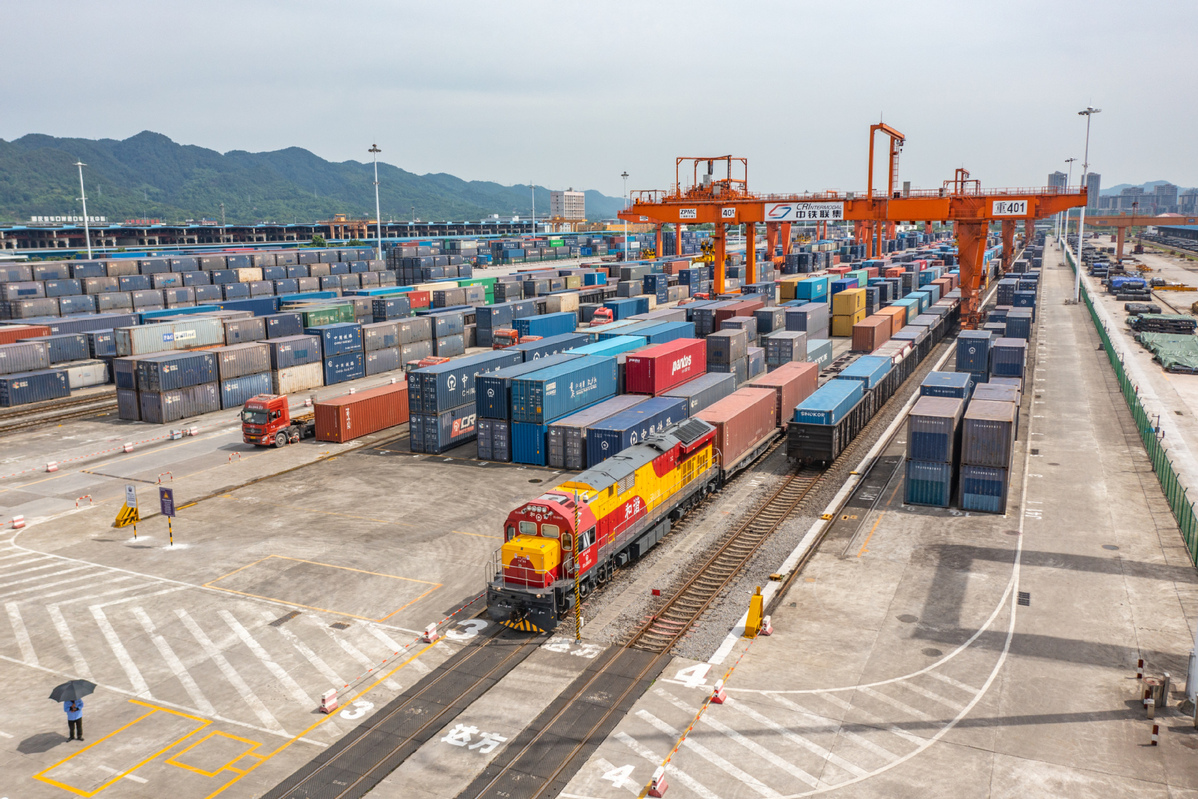 An aerial view of a China-Europe freight train waiting to depart from the Tuanjiecun Station in the Chongqing International Logistics Hub Park in Southwest China’s Chongqing municipality, May 5, 2024. [Photo/Xinhua]
An aerial view of a China-Europe freight train waiting to depart from the Tuanjiecun Station in the Chongqing International Logistics Hub Park in Southwest China’s Chongqing municipality, May 5, 2024. [Photo/Xinhua]
The Chongqing International Logistics Hub Park, which includes the Tuanjiecun Station, the dry port of the New International Land-Sea Trade Corridor and the Chongqing Railway Port, has risen to be a major hub of international freight trains in the country’s western region.
SCOR will “massively” boost investments in the Chinese market to capture the country’s long-term growth prospects, said Thierry Leger, chief executive officer of SCOR SE, a global reinsurer based in Paris, France, adding that he “disagrees strongly” with the arguments that China’s economic development has peaked because there remains potential in terms of consumer spending and digital transformation.
China is expected to become the world’s second-largest market for reinsurance in the coming decade, attracting global reinsurers like SCOR to ramp up investment in the country, said Leger.
Thanks to robust economic growth potential and a still large protection gap, the Chinese market offers incredible growth potential, whose contribution to SCOR’s overall business is expected to surge to at least 10 to 15 percent in the coming 10 to 20 years, Leger said in an exclusive interview with China Daily.
“So that shows the importance (of the Chinese market) and the need for us to continue to invest in our people, expertise, tools and data in the Chinese market.”
Liu Zhihua contributed to this story.

Grand delusions.Illustration: Chen Xia/GT
AIM Congress 2024, a premier global investment platform, kicked off today in Abu Dhabi under the theme “Adapting to a Shifting Investment Landscape: Harnessing New Potential for Global Economic Development”.
Set to take place until 9th May, AIM Congress 2024 boasts an impressive lineup of participants, including over 100 ministers, city mayors and central bank governors; 900 speakers; 11 global stock markets; 50 unicorn companies; and more than 12,000 delegates representing 175 countries worldwide. They will participate in 27 joint events organised in cooperation with more than 330 local, regional, and international partners.
AIM Congress is an initiative of the AIM Global Foundation and is organised with the support of the Ministry of Industry and Advanced Technology and the Abu Dhabi Department of Economic Development.
The current edition of the summit, held at the Abu Dhabi National Exhibition Centre (ADNEC), offers numerous opportunities for investors, businessmen, and investment companies from around the world to network and explore specialised investment projects across various sectors, featuring 450 dialogue sessions and seven high-level roundtable meetings.

Illustration: Liu Xiangya/GT
The construction of the Hungary-Serbia railway, a flagship project of the China-proposed Belt and Road initiative (BRI), will help inject new impetus into the economies of the two countries. The railway, plus the China-Serbia Free Trade Agreement (FTA) signed in 2023, may provide people with a new perspective on the increasingly fragmented global trade situation.
As reported by the Xinhua News Agency on Sunday, Serbia’s Minister of Construction, Transport and Infrastructure Goran Vesic said that Serbia’s participation in the BRI has boosted the overall development of the country and its neighbors. He cited the construction of the Hungary-Serbia railway as an example of successful BRI cooperation.
The Hungary-Serbia railway is a double-track electrified railway with a total length of 341.7 kilometers, including 183.1 kilometers in Serbia. Sitting at the crossroads of Central and Southern Europe – and often seen as a geographical region that straddles both Eastern and Western Europe – Serbia has unique geographical advantages. The construction of the railway is expected to improve connectivity between Hungary and Serbia and help clear barriers from Serbia to Greece’s Piraeus Port, a transit hub connecting Europe, Asia and Africa.
The Hungary-Serbia railway is considered an important project to improve physical connectivity, as part of multifaceted cooperation aimed at deepening economic exchanges.
Connectivity includes not only physical infrastructure like roads and railways but also institutional arrangements to make it easier to strengthen exchanges among different regions.
China and Serbia signed an FTA in October 2023. The signing of the FTA and subsequent tariff cuts have enhanced trade relations, boosted Serbia’s exports and – more importantly – served as a bridge to open up new trade routes and ramp up trade and investment between China and Europe.
Trade between China and Europe reached $1.215 trillion in 2023. Both sides have strong trade complementarity, and unleashing this potential can generate more positive influences on Europe’s economy, helping solve problems it faces, such as stubborn inflation.
The lingering question is how to unleash this huge potential. There are two critical factors. On the one hand, we should continue to promote infrastructure interconnectivity; on the other hand, we should take concrete actions to reject all forms of protectionism and unequivocally advocate for and support free trade.
Facing a complex and volatile international situation, China and Serbia, acting as each other’s “ironclad friends,” have continuously enhanced cooperation in multiple fields such as railway infrastructure construction and free trade. These factors interact with one another, forming a joint force to boost economic cooperation.
The nature of cooperation is mutually beneficial, and that’s why the Serbian side holds a positive attitude toward cooperation with China. Vesic said Serbia is proud of its participation in the BRI, under which Chinese companies have undertaken many infrastructure projects in the country.
The construction of the Hungary-Serbia railway reached a milestone on April 25, when the track-laying work for a 108-kilometer section between Novi Sad and Subotica in Serbia was completed. It’s not always easy to undertake large-scale infrastructure projects, and the construction of the Hungary-Serbia railway faces some challenges, but the project has been steadily advancing. That’s because this is good for the Serbian economy, which could benefit greatly from infrastructure projects.
Amid global economic uncertainty, various countries, including those in Europe, are trying to gain new growth momentum as traditional drivers weaken. What is needed today is to improve economic connectivity and further promote free trade. As long as cooperation can bring tangible economic benefits to local economies, it will eventually overcome temporary challenges and difficulties.
The US-advocated “decoupling” and Washington’s geopolitical games have brought enormous challenges to global trade, but globalization and free trade are the only ways to promote mutually beneficial cooperation. Politicians with a sober mind will not politicize economic issues and not fall into the “decoupling from China” trap.
The author is a reporter with the Global Times. [email protected]
01:25

China’s Chang’e-6 lunar probe aims to land in the historically rich Apollo Craters region on the far side of the moon. Giuseppe Reibaldi, president of the Moon Village Association, speaking with CGTN, identified several technological hurdles associated with the mission. Chief among these is establishing reliable communication with the spacecraft while it operates on the far side of the moon. The target landing region’s varied altitude changes and rugged terrain increase the difficulty of launching from the lunar surface. But the area is “important” to understand the moon’s evolution, he said. Check out the video to learn more!
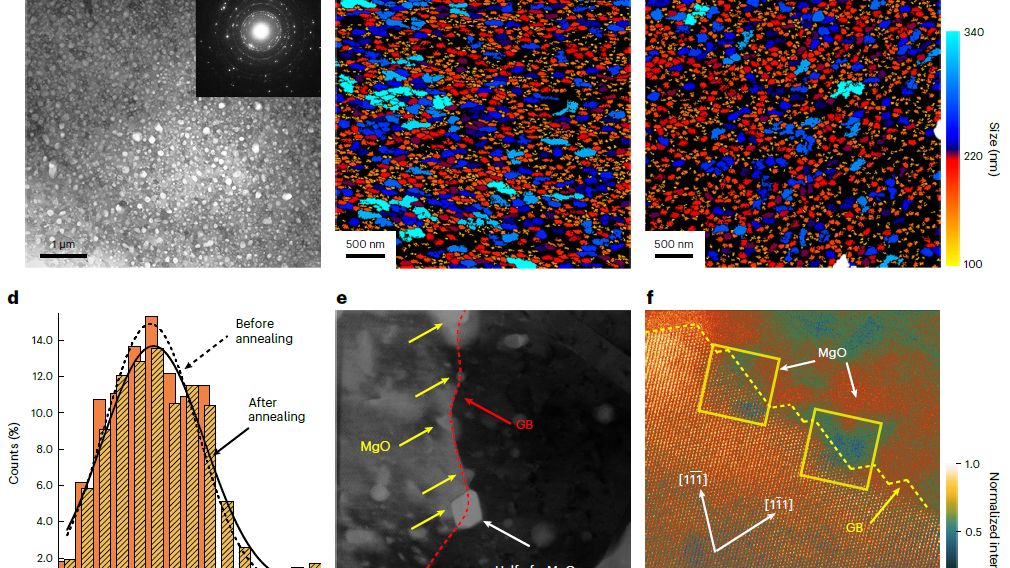 An illustration shows the novel high-strength aluminum alloy demonstrating exceptional resistance to high temperatures. /Tianjin University
An illustration shows the novel high-strength aluminum alloy demonstrating exceptional resistance to high temperatures. /Tianjin University
An illustration shows the novel high-strength aluminum alloy demonstrating exceptional resistance to high temperatures. /Tianjin University
A team of Chinese scientists has developed a high-strength aluminum alloy that remains operational even at 500 degrees Celsius.
This advancement has extended the service temperature range of aluminum alloys from 350 to over 400 degrees Celsius, addressing a long-standing engineering challenge.
The demands of the aerospace industry have set higher standards for thermal resistance in lightweight metal materials.
This innovative process is characterized by its simplicity, minimal material costs and scalability, making it highly valuable for industrial applications, said He Chunnian from Tianjin University, the corresponding author of the paper.
Although aluminum alloys are favored for their low density, high strength and robust corrosion resistance, their relatively low heat-resistance poses a considerable challenge, especially within the crucial temperature range of 350 to 500 degrees Celsius, which is pivotal for aerospace applications.
Researchers at Tianjin University synthesized aluminum alloys embedded with highly dispersive nanoparticles. The nanoparticles have grown in-situ graphene-like coatings, which significantly contribute to a reduction in surface energy.
Thanks to the incorporation of these nanoparticles, the alloys exhibit exceptional creep resistance at elevated temperatures of up to 500 degrees Celsius, according to the study published recently in the journal Nature Materials.
They also boast an impressive tensile strength of approximately 200 megapascals at that temperature, about six times higher than ordinary aluminum alloys.
(With input from Xinhua)
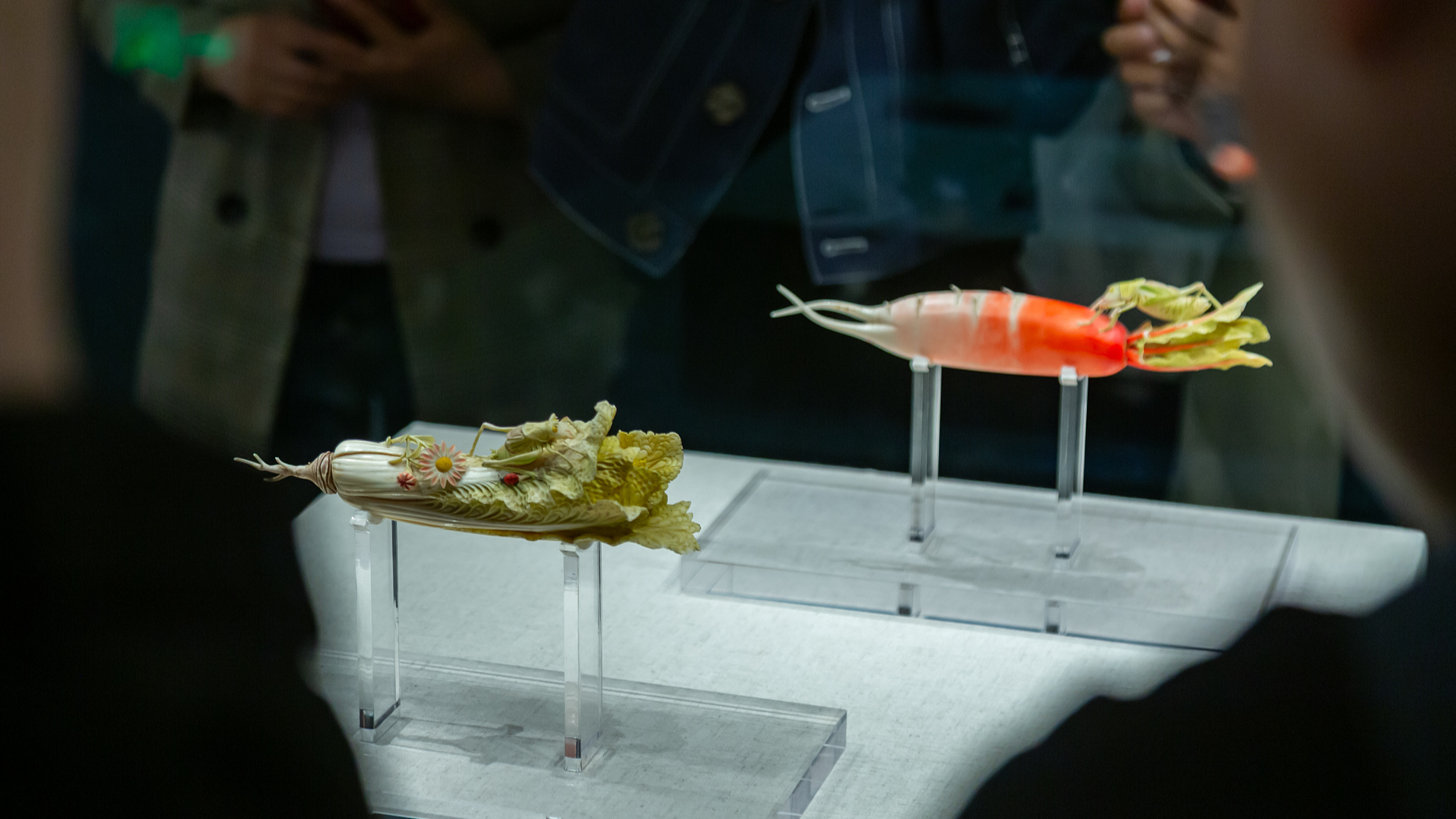 A photo taken on May 5, 2024 shows people appreciating ivory radish and cabbage on display at Henan Museum in Zhengzhou, Henan Province, China. /CFP
A photo taken on May 5, 2024 shows people appreciating ivory radish and cabbage on display at Henan Museum in Zhengzhou, Henan Province, China. /CFP
A photo taken on May 5, 2024 shows people appreciating ivory radish and cabbage on display at Henan Museum in Zhengzhou, Henan Province, China. /CFP
During the recently concluded May Day holiday, museums remained a hot destination. Henan, known as a province rich in cultural relics, has unearthed countless national treasures. Among the 130,000 artifacts housed in the Henan Museum, a pair of radish and cabbage sculptures stood out as one of the museum’s top 10 treasures.
As soon as the museum opened its doors, visitors flocked straight to the exhibition hall, equipped with professional cameras, eager to capture their favorite star exhibits. What kind of radish and cabbage could withstand the test of centuries and still look so “fresh and tender?”
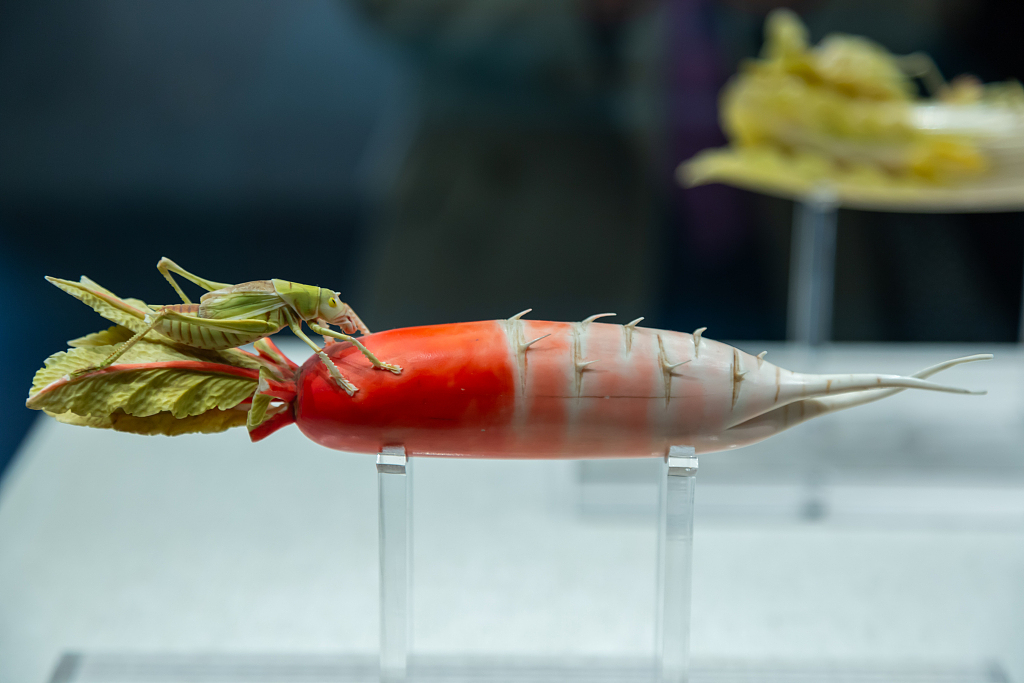 A photo taken on May 5, 2024 shows a closer look at the ivory radish on display at Henan Museum in Zhengzhou, Henan Province, China. /CFP
A photo taken on May 5, 2024 shows a closer look at the ivory radish on display at Henan Museum in Zhengzhou, Henan Province, China. /CFP
A photo taken on May 5, 2024 shows a closer look at the ivory radish on display at Henan Museum in Zhengzhou, Henan Province, China. /CFP
This is a pair of radish and cabbage carvings made of ivory during the Qianlong period of the Qing Dynasty (1644-1911). The ivory radish is about 27 centimeters long and weighs 229 grams. Its root gradually changes from red at the top to pink in the middle and white at the base, with naturally curved roots. The green leaves, with their main veins dyed red, exude a sense of movement as a grasshopper extends its front legs from the radish leaves toward the stem, eagerly seeking the sweet juice.
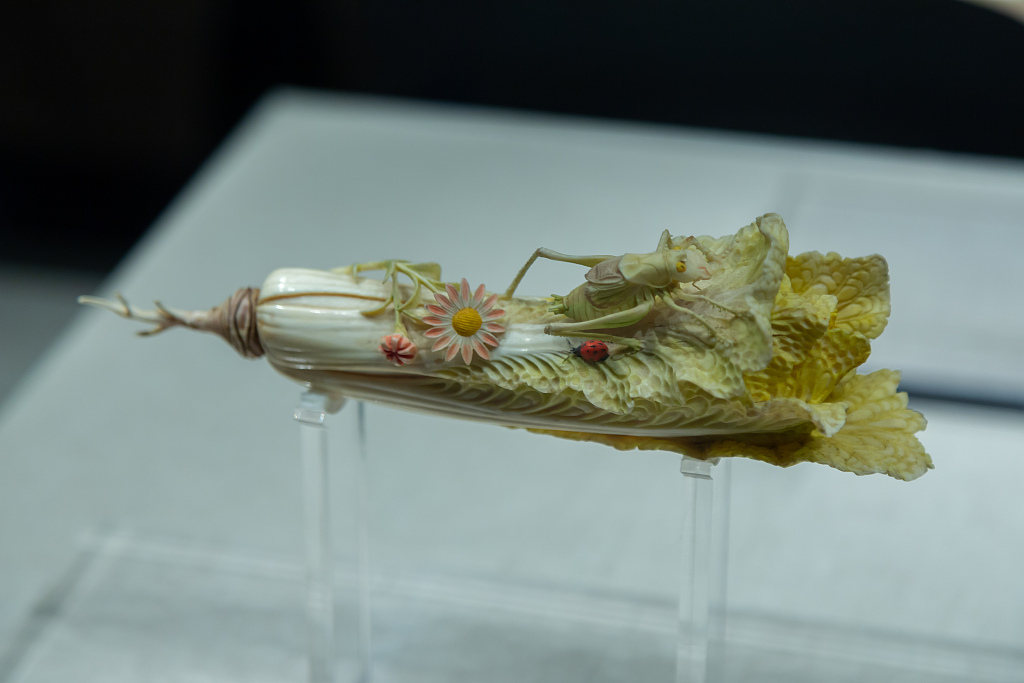 A photo taken on May 5, 2024 shows a closer look at the ivory cabbage on displayed at Henan Museum in Zhengzhou, Henan Province, China. /CFP
A photo taken on May 5, 2024 shows a closer look at the ivory cabbage on displayed at Henan Museum in Zhengzhou, Henan Province, China. /CFP
A photo taken on May 5, 2024 shows a closer look at the ivory cabbage on displayed at Henan Museum in Zhengzhou, Henan Province, China. /CFP
About 23 centimeters long and weighing 260 grams, the ivory cabbage shows layers of its white stem, green leaves, yellow heart and brown roots with clear veins. Two small flowers adorn the stem, one budding and the other in full bloom. A grasshopper rests on the back of the cabbage, blending seamlessly with the green leaves as it savors the fresh juice. Next to it lies a ladybug, its antennae barely visible, seemingly absorbed in its own feast.
The homophony of “cabbage” and “radish” in Chinese conveys the auspicious notions of continued prosperity and progress. In Chinese culture, grasshoppers symbolize family prosperity and longevity due to their strong reproductive abilities. So, the themes of “radish,” “cabbage,” and “grasshoppers” were common in art during the Ming (1368-1644) and Qing (1644-1911) dynasties, signifying auspiciousness through imagery.
These ivory radish and cabbage exhibits not only showcase the craftsmanship of ancient artisans but also reveals the profound symbolism of auspiciousness in traditional Chinese culture.